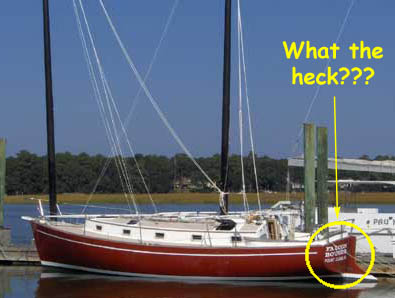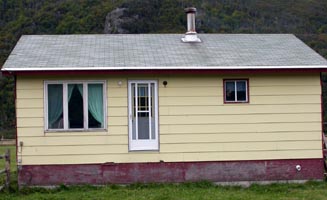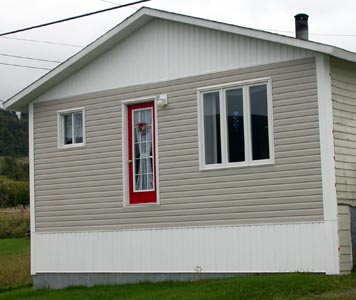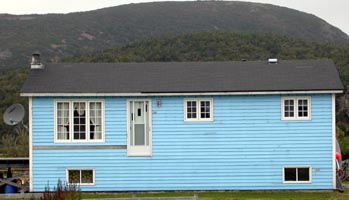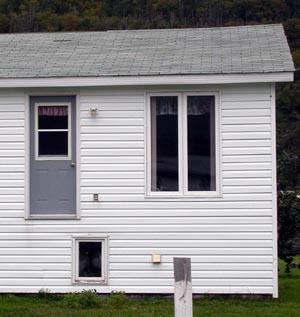Before going to bed, I clambered over the hatch boards and stood in the dark cockpit, my elegant red velvet and bunny-fur slippers protecting my feet from the cold. At first, only the quiet exhales of nearby dolphins broke the silence — chuff! chuff!
On the horizon, four bright white flares filled the sky and dimmed the stars. Then an explosion split the air, a sound so loud I wished I’d had my fingers in my ears. We’d recently met a man who bought a used Catalina with an unbelievably loud generator, and he’d discovered handfuls of used earplugs under the mattresses in both staterooms. I was wishing I had a few earplugs right now, used or unused.
I fled down the companionway to the cabin, where the sound was at least muffled.
Earlier that day, we had puttered through the Onslow Beach bridge, owned and operated by the U.S. Marine Corps, at 1 pm. We were looking forward to stopping in mid-afternoon at Swansboro, an old-fashioned North Carolina waterfront town.
Just north of the bridge, we passed the large sign warning of the Camp Lejeune firing zone, but the lights weren’t flashing, so we continued on. I went below to make some lunch, putting cheese and salami and crackers into a bowl for Barry. Just as I reached for a can of sardines for myself, he suddenly throttled back to idle speed and began a swift U-turn.
Anchored in the channel was a small gray military boat with a soldier on the bow. It was a stake boat, anchored there to stop us from proceeding into a live firing zone. The ICW was closed, probably until 4 pm. We suddenly realized that we’d shifted our radio to Channel 13 to talk with the bridge tender, and we hadn’t shifted back to 16. Since they’d been unable to hail us on the radio, they resorted to a megaphone and a blue flashing light. They were very polite.
We dropped our anchor in the middle of the channel and settled down for our lunch. A second, smaller military boat came and rafted with the first one, and two men wearing camouflage fatigues climbed into the larger boat’s pilothouse.
Earlier, we’d heard a warship on the radio, warning boats offshore of a firing exercise, and we’d heard sounds of distant shelling. But for now, there were no signs of the firing that was closing down the waterway.
Around us, the water was calm, surrounded by lovely marshland. A pod of dolphins came by and fished a short distance away. Then a handful of pelicans found the fish as well. They dove at tops speeds, hitting the water beak first with a giant splash, then placidly bobbing up, their heads aimed 180 degrees from the direction they landed.
Terns grabbed some of the fish, too, quick hitters and acrobatic fliers. One little tern got chased across the blue sky by a couple of large gulls, and he evaded them and entertained us with his maneuvers.
Distant firing began to the northwest, and the sky was tinged with plumes of gray-brown smoke. Then more firing to the southwest, and then, so loud it frightened me, giant explosions offshore. It seemed like they were firing all around us, but the fellows on the boats anchored nearby were unperturbed. I progressed from jumpy to annoyed with the loud noises, which sounded like fireworks, but didn’t provoke any oohs or aahs.
If the waterway had opened at 4 pm, as expected, we’d have made it to our snug anchorage at Swansboro. But 5 pm came, and the sun began to set, filling the sky with pinks and blues that brought to mind the ceiling of the Sistine Chapel. The gray boats anchored off our bow were nothing Michelangelo ever painted.
The sky was almost indigo when a terse radio message finally announced that the waterway was opening. It was too dark for us to move safely; we were near a spot that we’d heard had less than 4 feet at low tide.
Our neighbors on the patrol boats came by to say farewell; they’d stopped by to chat earlier in the afternoon, wanting to know about our boat. “I’ve never seen one with two masts like that,” said one of the fellows. The other one was more sailboat-savvy, and actually owned a little sailboat.
We radioed the two boats who’d been stuck at the other end of the closed zone. We warned them of our plans to stay anchored in the channel all night, and one of them agreed that he was doing the same.
Although the waterway was officially open, the offshore firing continued into the night. The following morning, it was finally quiet, and only the dolphins and birds greeted us as we pulled up our anchor and motored north. A few miles later, we passed the other vessel who’d spent the night anchored in the waterway.
By some strange coincidence, the name of his boat was Peacekeeper.

